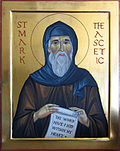Top Qs
Timeline
Chat
Perspective
May 20 (Eastern Orthodox liturgics)
From Wikipedia, the free encyclopedia
Remove ads
May 19 - Eastern Orthodox Church calendar - May 21
This article needs editing to comply with Wikipedia's Manual of Style. In particular, it has problems with using bold text for emphasis - see MOS:NOBOLD. (May 2019) |

All fixed commemorations below celebrated on June 2 by Orthodox Churches on the Old Calendar.[note 1]
For May 20th, Orthodox Churches on the Old Calendar commemorate the Saints listed on May 7.
Remove ads
Saints
- Saint Lydia of Thyatira (Lydia of Philippi), mentioned in Acts 16:14-15 (1st century)[1][note 2]
- Martyrs Thalelaeus the Unmercenary, at Anazarbus in Cilicia, and his companions Alexander and Asterius (284)[2][3][note 3]
- Martyr Asclas of the Thebaid, Egypt (287)[4]
- Sts. Zabulon and Susanna, of Cappadocia and Jerusalem (parents of St. Nina (Nino), enlightener of Georgia), (4th century)[5]
- Saint Mark the Hermit (Marcus Eremita) (5th century)[6]
- Holy Martyrs of Mamilla, Jerusalem (614)[7]
- Saint Thalassius the Myrrh-gusher, of Libya (648)[8][note 4]
- Saints John, Joseph and Nicetas, monks of Nea Moni on Chios (c. 1050)[10]
Remove ads
Pre-Schism Western saints
- Saint Plautilla the Roman, martyr, (67)[3][11][note 5]
- Hieromartyr Baudelius, missionary in France and northern Spain, martyred in Nîmes (2nd or 3rd century)[3][12]
- Virgin-martyr Basilla (304)[3][13]
- Saint Hilary (Hilarius, Hilaire), Bishop of Toulouse in France (360)[13][14]
- Saint Anastasius, Bishop of Brescia in Lombardy, in Italy (610)[3][13][15][note 6]
- Saint Austregisilus (Aoustrille, Outrille), Bishop of Bourges and Confessor (624)[3][13][16]
- Saint Theodore of Pavia, Bishop of Pavia (778)[3][13][17]
- Saint Ethelbert (Albert, Albright), King of East Anglia in England, martyr (794)[13][18] (see also May 29)
- Saint Alcuin of York, monk (804)[19]
Remove ads
Post-Schism Orthodox saints
- St. Daumantas (Timothy, Dovmont-Timothy), prince of Pskov (1299)[20][21]
- Saint Stephen, Abbot of Piperi in Serbia (1697)[22]
New martyrs and confessors
Other commemorations
- Translation of the holy relics (1087) of Saint Nicholas the Wonderworker (343)[27][note 9] (see also: May 9 - Slavonic)
- Uncovering of the relics (1431) of St. Alexis, Metropolitan of Moscow, Wonderworker (1378)[28]
- Repose of Schema-monk Cyriacus of Valaam (1798)[29]
Icon gallery
- St. Lydia of Thyatira.
- St. Marcus Eremita.
- Church of St. Theodore of Pavia, in Pavia.
- The martyred Anglo-Saxon king Æthelberht II of East Anglia (depiction of a brass plate from Hereford Cathedral).
- St. Daumantas of Pskov.
- St. Stephen of Piperi.
- St. Alexius, Metropolitan of Moscow.
Notes
- The notation Old Style or (OS) is sometimes used to indicate a date in the Julian Calendar (which is used by churches on the "Old Calendar").
The notation New Style or (NS), indicates a date in the Revised Julian calendar (which is used by churches on the "New Calendar"). - The Church honours Saint Lydia as "Equal-to-the-Apostles."[1]
- It appears that certain monasteries honoured Saint Thalelaeus' feast day on September 3, and others on August 23, the day on which he was brought to trial.[2]
- Not to be confused with Thalassius of Syria (February 22).[9]
- Red partisans took Fr. Pavel and interrogated him in the local elementary school. As a condition of his release, Fr. Pavel was asked to declare that he had deceived people with a made-up God and to publicly remove his cross and cassock. He firmly declared that he would never renounce God and that he was ready to accept death for his faith in Christ. Fr. Pavel was martyred on the feast of Pentecost, June 2, in 1919. Seriously wounded after being shot, he was left to die in the forest near Nikitovka.)[23]
Remove ads
References
Sources
Wikiwand - on
Seamless Wikipedia browsing. On steroids.
Remove ads







